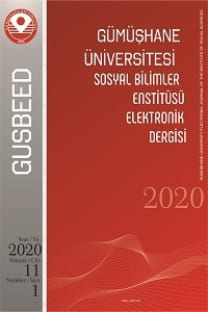Kur Savaşları Çerçevesinde Döviz Kurları Arasındaki Volatilite Etkileşimi
Bu çalışmanın amacı, kur savaşları çerçevesinde Amerikan
Doları, Euro, Yuan ve Yen döviz kurları arasındaki volatilite etkileşiminin ve
aktarımının araştırılmasıdır. Çalışmanın amacı kapsamında döviz kurları
arasındaki volatilite etkileşimini araştırmak için 20.03.2012-28.09.2018 dönemi
günlük veriler dikkate alınarak, Dinamik Korelasyonlu Çok Değişkenli Stokastik
Volatilite (DC-MSV) modeli kullanılmıştır. Elde edilen sonuçlar, kur savaşları
çerçevesinde döviz piyasaları arasındaki volatilite etkileşiminin varlığını
işaret etmektedir. Analiz sonucunda belirleyici piyasaların sırasıyla Yuan,
Euro, Amerikan Doları ve Yen piyasaları olduğu sonucuna ulaşılmıştır. Yuan
döviz piyasası kur savaşları çerçevesinde en güçlü piyasa iken Yen döviz
piyasasının ise bu savaşta en güçsüz piyasa olduğu belirlenmiştir.
Anahtar Kelimeler:
Stokastik Volatilite, Kur Savaşları, Volatilite Etkileşimi
Volatility Transmission Among Exchange Rates in Case of Currency Wars
The aim of the
study is to analyze volatility spillovers and transmission among the U.S.
Dollar, the Euro, the Yuan and the Yen within the framework of currency wars.
Towards to the purpose of the study, we use the daily dataset that covers the
period 20.03.2012-28.09.2018 and volatility spillovers among exchange rates are
investigated with Dynamic Correlation Multivariate Stochastic Volatility
(DC-MSV) model. According to the results, there exists volatility transmission
among the exchange rates in case of currency wars. Also considering the results
of the amount of volatility transmission, the determinant currency markets are
Yuan, Euro, the U.S. Dollar and Yen, respectively. The Yuan is the most
powerful currency market and the Yen is the weakest currency market in the
currency wars.
Keywords:
Stochastic Volatility, Currency War, Volatility Transmission,
___
Asai, M. ve McAleer, M. ve Yu, J. (2006), “Multivariate Stochastic Volatility: A Review”, Econometrics Reviews, Vol. 25, No: 2-3, s. 145-175.Bahmani-Oskooee, M. (2001), “Nominal and Real Effective Exchange Rates of Middle Eastern Countries and Their Trade Performance” Applied Economics, 33:1, s.103-111.
Bubak,V. ,Kocenda, E. ve Zikes, F. (2011), “Volatility Transmission in Emerging European Foreign Exchange Markets”, Journal of Banking &Finance, 35, s.2829-2841.
Carsamer, E. (2016), "Volatility transmission in African foreign exchange markets", African Journal of Economic and Management Studies, Vol. 7 Issue: 2, s.205-224.
Chib, S. , Omori, Y. ve Asai, M. (2006), “Analysis of High Dimensional Multivariate Stochastic Volatility Models”, Journal of Econometrics, Vol. 134,No: 2, s. 341-371.
Danielsson J. (1998), “Multivariate Stochastic Volatility Models: Estimation and a Comparison with VGARCH Models”, Journal of Empirical Finance, Vol. 5, No: 2, s. 155-173.
Das A., Ghoshal, T. K. ve Basu P. N. (2009), “A Review of on Recent Trends of Stochastic Volatility Models”, International Review of Applied Financial Issues and Economics, 1(1), s. 83-116.
Harvey, A., Ruiz, E. ve Shephard, N.(1994) , “Multivariate Stochastic Variance Models”, The Review of Economic Studies, Vol. 61, No: 2, s. 247-264.
Hepsağ, A. (2013), “Çok Değişkenli Stokastik Oynaklık Modelleri: Petrol Piyasası ile Finansal Piyasalarda İşlem Gören Sanayi Sektörü Endeksi Arasındaki Volatilite Etkileşimi”, İktisadi Araştırmalar Vakfı Yayınları, İstanbul.
Mankiw, N. G. (2010), “Makro Ekonomi” ,(6. baskı) , Efil Yayınevi, Ankara
Pellegrini S. ve Rodrigez A. (2001), “Financial Econometrics and SV models”, http://halweb.uc3m.es/esp/Personal/personas/spellegr/esp/Curso_Cordoba/Tutorial_G uide.pdf, (14.08.2018)
Vo, M. (2011), “Oil and Stock Market Volatility: A Multivariate Stochastic Volatility Perspective”, Energy Economics, 33(5),s. 956-965.
Yu, J., Meyer, R. (2006), “Multivariate Stochastic Volatility Models: Bayesian Estimation and Model Comparison”, Econometric Reviews, 25(2-3), s.361-384.
- ISSN: 1309-7423
- Yayın Aralığı: Yılda 3 Sayı
- Yayıncı: Gümüşhane Üniversitesi
Sayıdaki Diğer Makaleler
Türkiye’nin 1960-1980 Dönemindeki Parti Sisteminin Değerlendirilmesi
Affetme Niyeti Eleştirel Düşünme Eğilimine Duyarlı Mıdır?
BRICS Ülkelerinin Afrika’daki Yükselişine Jeopolitik Ekonomi Penceresinden Bir Bakış
Sahra Altı Afrika Ülkelerinin Makroekonomik Performanslarının TOPSIS Metodu İle Karşılaştırılması
Mehmet ELA, Halenur SOYSAL KURT
Çağdaş CAZ, Yunus Serhat BIÇAKÇI, F.firuzan NAKİPOĞLU
İşletmelerin Bağımsız Denetime Bakış Açıları Üzerine Bir Araştırma: Sivas İli Örneği
